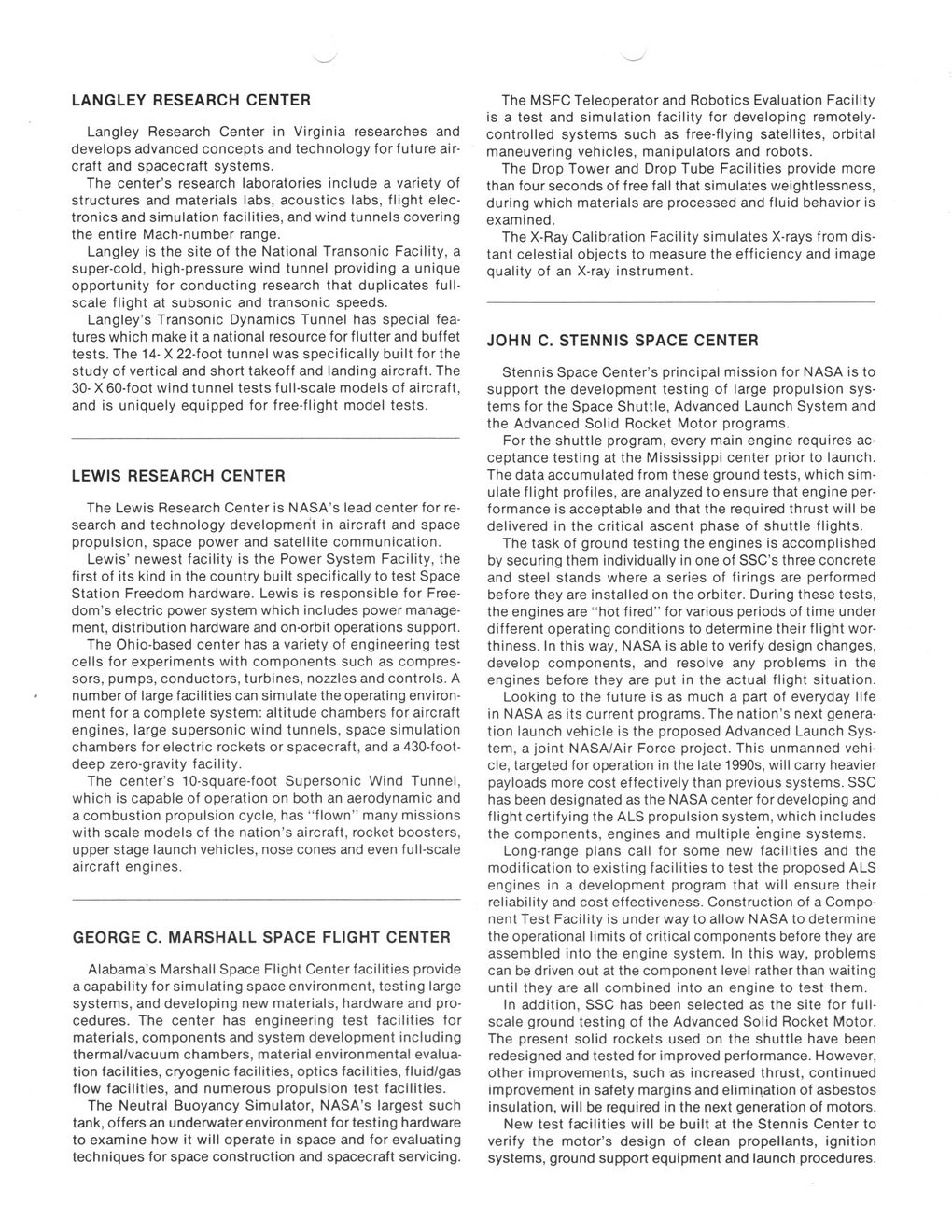This text was obtained via automated optical character recognition.
It has not been edited and may therefore contain several errors.
LANGLEY RESEARCH CENTER Langley Research Center in Virginia researches and develops advanced concepts and technology for future aircraft and spacecraft systems. The center’s research laboratories include a variety of structures and materials labs, acoustics labs, flight electronics and simulation facilities, and wind tunnels covering the entire Mach-number range. Langley is the site of the National Transonic Facility, a super-cold, high-pressure wind tunnel providing a unique opportunity for conducting research that duplicates full-scale flight at subsonic and transonic speeds. Langley’s Transonic Dynamics Tunnel has special features which make it a national resource for flutter and buffet tests. The 14- X 22-foot tunnel was specifically built for the study of vertical and short takeoff and landing aircraft. The 30- X 60-foot wind tunnel tests full-scale models of aircraft, and is uniquely equipped for free-flight model tests. LEWIS RESEARCH CENTER The Lewis Research Center is NASA’s lead center for research and technology development in aircraft and space propulsion, space power and satellite communication. Lewis’ newest facility is the Power System Facility, the first of its kind in the country built specifically to test Space Station Freedom hardware. Lewis is responsible for Freedom’s electric power system which includes power management, distribution hardware and on-orbit operations support. The Ohio-based center has a variety of engineering test cells for experiments with components such as compressors, pumps, conductors, turbines, nozzles and controls. A number of large facilities can simulate the operating environment for a complete system: altitude chambers for aircraft engines, large supersonic wind tunnels, space simulation chambers for electric rockets or spacecraft, and a 430-foot-deep zero-gravity facility. The center’s 10-square-foot Supersonic Wind Tunnel, which is capable of operation on both an aerodynamic and a combustion propulsion cycle, has “flown” many missions with scale models of the nation’s aircraft, rocket boosters, upper stage launch vehicles, nose cones and even full-scale aircraft engines. GEORGE C. MARSHALL SPACE FLIGHT CENTER Alabama’s Marshall Space Flight Center facilities provide a capability for simulating space environment, testing large systems, and developing new materials, hardware and procedures. The center has engineering test facilities for materials, components and system development including thermal/vacuum chambers, material environmental evaluation facilities, cryogenic facilities, optics facilities, fluid/gas flow facilities, and numerous propulsion test facilities. The Neutral Buoyancy Simulator, NASA’s largest such tank, offers an underwater environment for testing hardware to examine how it will operate in space and for evaluating techniques for space construction and spacecraft servicing. The MSFC Teleoperator and Robotics Evaluation Facility is a test and simulation facility for developing remotely-controlled systems such as free-flying satellites, orbital maneuvering vehicles, manipulators and robots. The Drop Tower and Drop Tube Facilities provide more than four seconds of free fall that simulates weightlessness, during which materials are processed and fluid behavior is examined. The X-Ray Calibration Facility simulates X-rays from distant celestial objects to measure the efficiency and image quality of an X-ray instrument. JOHN C. STENNIS SPACE CENTER Stennis Space Center’s principal mission for NASA is to support the development testing of large propulsion systems for the Space Shuttle, Advanced Launch System and the Advanced Solid Rocket Motor programs. For the shuttle program, every main engine requires acceptance testing at the Mississippi center prior to launch. The data accumulated from these ground tests, which simulate flight profiles, are analyzed to ensure that engine performance is acceptable and that the required thrust will be delivered in the critical ascent phase of shuttle flights. The task of ground testing the engines is accomplished by securing them individually in one of SSC’s three concrete and steel stands where a series of firings are performed before they are installed on the orbiter. During these tests, the engines are “hot fired” for various periods of time under different operating conditions to determine their flight worthiness. In this way, NASA is able to verify design changes, develop components, and resolve any problems in the engines before they are put in the actual flight situation. Looking to the future is as much a part of everyday life in NASA as its current programs. The nation’s next generation launch vehicle is the proposed Advanced Launch System, a joint NASA/Air Force project. This unmanned vehicle, targeted for operation in the late 1990s, will carry heavier payloads more cost effectively than previous systems. SSC has been designated as the NASA center for developing and flight certifying the ALS propulsion system, which includes the components, engines and multiple engine systems. Long-range plans call for some new facilities and the modification to existing facilities to test the proposed ALS engines in a development program that will ensure their reliability and cost effectiveness. Construction of a Component Test Facility is under way to allow NASA to determine the operational limits of critical components before they are assembled into the engine system. In this way, problems can be driven out at the component level rather than waiting until they are all combined into an engine to test them. In addition, SSC has been selected as the site for full-scale ground testing of the Advanced Solid Rocket Motor. The present solid rockets used on the shuttle have been redesigned and tested for improved performance. However, other improvements, such as increased thrust, continued improvement in safety margins and elimination of asbestos insulation, will be required in the next generation of motors. New test facilities will be built at the Stennis Center to verify the motor’s design of clean propellants, ignition systems, ground support equipment and launch procedures.

NASA Document (065)